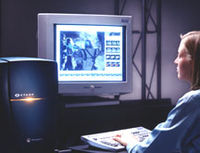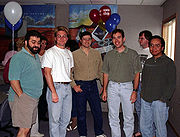
Avid Elastic Reality
Encyclopedia

Morphing
Morphing is a special effect in motion pictures and animations that changes one image into another through a seamless transition. Most often it is used to depict one person turning into another through technological means or as part of a fantasy or surreal sequence. Traditionally such a depiction...
software application available on Windows
Microsoft Windows
Microsoft Windows is a series of operating systems produced by Microsoft.Microsoft introduced an operating environment named Windows on November 20, 1985 as an add-on to MS-DOS in response to the growing interest in graphical user interfaces . Microsoft Windows came to dominate the world's personal...
, Macintosh
Macintosh
The Macintosh , or Mac, is a series of several lines of personal computers designed, developed, and marketed by Apple Inc. The first Macintosh was introduced by Apple's then-chairman Steve Jobs on January 24, 1984; it was the first commercially successful personal computer to feature a mouse and a...
and Silicon Graphics
Silicon Graphics
Silicon Graphics, Inc. was a manufacturer of high-performance computing solutions, including computer hardware and software, founded in 1981 by Jim Clark...
workstation
Workstation
A workstation is a high-end microcomputer designed for technical or scientific applications. Intended primarily to be used by one person at a time, they are commonly connected to a local area network and run multi-user operating systems...
s, discontinued in 1999.
Features
The workflow of the application is based around drawing source and destination curves or shapes onto an image using bézier curveBézier curve
A Bézier curve is a parametric curve frequently used in computer graphics and related fields. Generalizations of Bézier curves to higher dimensions are called Bézier surfaces, of which the Bézier triangle is a special case....
tools. The software then automatically generates an animated distortion of the image, commonly called a warp. If the warp is used to blend two images together, the effect is called morphing
Morphing
Morphing is a special effect in motion pictures and animations that changes one image into another through a seamless transition. Most often it is used to depict one person turning into another through technological means or as part of a fantasy or surreal sequence. Traditionally such a depiction...
. Elastic Reality made its name with the ease of use of its tool, and the quality of the resulting warps. Other warping tools have typically offered a simpler warping and morphing based on animating points on a grid, which can require significantly more work from the artist to animate distortion of organic shapes such as human faces.
The application also featured basic color correction and image compositing tools, as well as the ability to keyframe the motion of bézier shapes in groups and onto motion paths, and could be used for motion graphics effects not typically associated with morphing. The application supported 8-bit and 16-bit images, and image sequences.
History

Avid Technology
Avid Technology, Inc. is an American company specializing in video and audio production technology; specifically, digital non-linear editing systems, management and distribution services. It was created in 1987 and became a publicly traded company in 1993...
in march 1995. The product was rebranded Softimage Elastic Reality after Avid separately acquired Softimage
Softimage
Softimage, Co. was a company located in Montreal, Quebec, Canada that produced 3D animation software. Their flagship products, Softimage 3D and Softimage XSI, are used in the creation of computer animation for films, television advertisement, and video games...
in 1998.
Before 1994, ASDG had started on the Amiga, and produced an image processing application called Art Department Professional (ADPro), and in 1992 a precursor to Elastic Reality called MorphPlus. Other software products included Image Independence (graphic file conversion and scaling), ASDG Abekas driver, Lightning F/X (for lightning effects (Later called Avid LFX)) and NSA (No Strings Attached) for removing wires from live action effects.
As early as 1994, Elastic Reality for SGI, (written by Paul Miller at ASDG in collaboration with Ted Fay at VisionArt
VisionArt
"VisionArt Design & Animation'" was a motion picture and television visual effects company, founded in the 1980s by David Rose and Todd Hess. Though originally a small Orange County company working primarily on cable TV advertisements and flying logos, VisionArt moved to Santa Monica in 1992,...
) became the de facto morphing system in the film and broadcast industry, and contributed to hundreds of feature films and television effects, including Star Trek: Deep Space Nine
Star Trek: Deep Space Nine
Star Trek: Deep Space Nine is a science fiction television series set in the Star Trek universe...
"The Mask" and "Batman Forever."
Elastic Reality continues to be used in the present day on old computers maintained for the purpose of running Elastic Reality.
In 1997, Avid made the core image warping engine available in the form of one morphing and one image warping effect in Avid Media Illusion
Avid Media Illusion
Avid Media Illusion was a digital nonlinear compositing software by Avid Technology targeted at the film and television markets. It ran on Silicon Graphics workstations. The main features were paint, compositing, image manipulation and special effects....
5.0. These effects were integrated one year later in Avid|DS's image compositing module. The newest product to make these available is SoftimageXSI v6.0
Softimage XSI
Autodesk Softimage, or simply Softimage is a 3D computer graphics application, owned by Autodesk, for producing 3D computer graphics, 3D modeling, and computer animation...
, released in December 2006, which features an integrated 2D image compositing module that is derived from Avid Media Illusion 6.0.
Compared to the classic Elastic Reality application, these effects use the 2D shape, user interface and other features native to these products, and the interaction is different, although the end results can be the same. For example, in Avid Media Illusion and XSI 6.0, morphs can be performed with B-spline
B-spline
In the mathematical subfield of numerical analysis, a B-spline is a spline function that has minimal support with respect to a given degree, smoothness, and domain partition. B-splines were investigated as early as the nineteenth century by Nikolai Lobachevsky...
curves and polygonal lines, can process 16-bit images, and offer an interactive OpenGL preview of the warp. The classic Elastic Reality application offered only Bezier curve
Bézier curve
A Bézier curve is a parametric curve frequently used in computer graphics and related fields. Generalizations of Bézier curves to higher dimensions are called Bézier surfaces, of which the Bézier triangle is a special case....
, 8-bit image processing, and a wireframe preview which required a rendering step for accurate preview. In Avid DS, the built-in 2D tracker can be used to procedurally animate the shapes. In all three host applications, the effects are offered as image operators inside an image compositing tree, and do not require launching a separate application which makes it easier to use in conjunction with other tools. On the other hand, the classic Elastic Reality application featured items like shape grouping which could be used for matting or complex intersection groups, a path tracing tool, and more seldom used motion graphics tools to constrain and animate shapes on a path and edit keyframes. Avid DS features equivalent animation tools in its "Graphics" module, and standard tools in these host applications can be used to mask and combine image warping effects, often in ways more powerful than the classic Elastic Reality application offered.
Awards
Perry KivolowitzPerry Kivolowitz
Perry Kivolowitz is an American computer scientist and business person. In 1985, he co-founded Advanced Systems Design Group which built hardware for the Commodore Amiga. This company was renamed Elastic Reality, Inc. and became well known as a digital imaging software provider...
and Garth Dickie received a 1996 Technical Achievement Award from the Academy of Motion Picture Arts and Sciences for the development of Elastic Reality.
Release history
| Version | Company | Hardware | O/S | Release date | Price | Comments / Significant changes (selected) | |
|---|---|---|---|---|---|---|---|
| MorphPlus | ADSG Inc. | Amiga | Amiga OS | 1992 | 49$ | ||
| Elastic Reality 1.0 | ADSG Inc. | Mac OS | 1993 | 995$, promo 345$ | |||
| Windows | August 1994 | 495$ | 1st Windows release. Comes with a transition generator (stand-alone) called TransJammer. Byte "Best of Comdex" award at COMDEX. Similar to SGI version 1.3 plus some compositing features of the SGI 2.0 release | ||||
| Elastic Reality 2.0 | Elastic Reality Inc. | SGI | October 1994 | 5,000$ | Additional compositing tools not found in the Mac version (multiple matte types and composite stages). Regional color-correction and matte boolean operations. |
||
| Elastic Reality 3.0 | Avid Technology Inc. | IRIX | 1996 | 3,000$ | |||
| Windows | April 7, 1997 | 999$,495$,299$ | |||||
| Mac OS | July 3, 1997 | 999$,495$,299$ |

